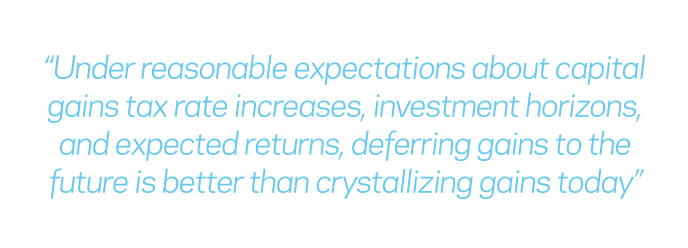This document has been provided to you solely for information purposes and does not constitute an offer or solicitation of an offer or any advice or recommendation to purchase any securities or other financial instruments and may not be construed as such. The factual information set forth herein has been obtained or derived from sources believed by the author and AQR Capital Management, LLC (“AQR”) to be reliable but it is not necessarily all-inclusive and is not guaranteed as to its accuracy and is not to be regarded as a representation or warranty, express or implied, as to the information’s accuracy or completeness, nor should the attached information serve as the basis of any investment decision. This document is intended exclusively for the use of the person to whom it has been delivered by AQR, and it is not to be reproduced or redistributed to any other person. The information set forth herein has been provided to you as secondary information and should not be the primary source for any investment or allocation decision. Past performance is not a guarantee of future performance.
This material is not research and should not be treated as research. This paper does not represent valuation judgments with respect to any financial instrument, issuer, security or sector that may be described or referenced herein and does not represent a formal or official view of AQR. The views expressed reflect the current views as of the date hereof and neither the author nor AQR undertakes to advise you of any changes in the views expressed herein.
The information contained herein is only as current as of the date indicated, and may be superseded by subsequent market events or for other reasons. Charts and graphs provided herein are for illustrative purposes only. The information in this presentation has been developed internally and/or obtained from sources believed to be reliable; however, neither AQR nor the author guarantees the accuracy, adequacy or completeness of such information. Nothing contained herein constitutes investment, legal, tax or other advice nor is it to be relied on in making an investment or other decision. There can be no assurance that an investment strategy will be successful. Historic market trends are not reliable indicators of actual future market behavior or future performance of any particular investment which may differ materially, and should not be relied upon as such.
The information in this paper may contain projections or other forward-looking statements regarding future events, targets, forecasts or expectations regarding the strategies described herein, and is only current as of the date indicated. There is no assurance that such events or targets will be achieved, and may be significantly different from that shown here. The information in this document, including statements concerning financial market trends, is based on current market conditions, which will fluctuate and may be superseded by subsequent market events or for other reasons.
HYPOTHETICAL PERFORMANCE RESULTS HAVE MANY INHERENT LIMITATIONS, SOME OF WHICH, BUT NOT ALL, ARE DESCRIBED HEREIN. NO REPRESENTATION IS BEING MADE THAT ANY FUND OR ACCOUNT WILL OR IS LIKELY TO ACHIEVE PROFITS OR LOSSES SIMILAR TO THOSE SHOWN HEREIN. IN FACT, THERE ARE FREQUENTLY SHARP DIFFERENCES BETWEEN HYPOTHETICAL PERFORMANCE RESULTS AND THE ACTUAL RESULTS SUBSEQUENTLY REALIZED BY ANY PARTICULAR TRADING PROGRAM. ONE OF THE LIMITATIONS OF HYPOTHETICAL PERFORMANCE RESULTS IS THAT THEY ARE GENERALLY PREPARED WITH THE BENEFIT OF HINDSIGHT. IN ADDITION, HYPOTHETICAL TRADING DOES NOT INVOLVE FINANCIAL RISK, AND NO HYPOTHETICAL TRADING RECORD CAN COMPLETELY ACCOUNT FOR THE IMPACT OF FINANCIAL RISK IN ACTUAL TRADING. FOR EXAMPLE, THE ABILITY TO WITHSTAND LOSSES OR TO ADHERE TO A PARTICULAR TRADING PROGRAM IN SPITE OF TRADING LOSSES ARE MATERIAL POINTS THAT CAN ADVERSELY AFFECT ACTUAL TRADING RESULTS. THERE ARE NUMEROUS OTHER FACTORS RELATED TO THE MARKETS IN GENERAL OR TO THE IMPLEMENTATION OF ANY SPECIFIC TRADING PROGRAM WHICH CANNOT BE FULLY ACCOUNTED FOR IN THE PREPARATION OF HYPOTHETICAL PERFORMANCE RESULTS, ALL OF WHICH CAN ADVERSELY AFFECT ACTUAL TRADING RESULTS.
Risks of Tax Aware Strategies (Not Exhaustive)
1. Underperformance of pre-tax returns: tax aware strategies are investment strategies with the associated risk of pre-tax returns meaningfully underperforming expectations.
2. Adverse variation in tax benefits: deductible losses and expenses allocated by the strategy may be less than expected.
3. Lower marginal tax rates: the value of losses and expenses depends on an individual investor’s marginal tax rate, which may be lower than expected for reasons including low Adjusted Gross Income (AGI) due to unexpected losses and the Alternative Minimum Tax (AMT).
4. Inefficient use of allocated losses and expenses: the tax benefit of the strategy may be lower than expected if an investor cannot use the full value of losses and expenses allocated by the strategy to offset gains and income of the same character from other sources. This may occur for a variety of reasons including variation in gains and income realized by other investments, at-risk rules, limitation on excess business losses and/or net interest expense, or insufficient outside cost basis in a partnership.
5. Larger tax on redemption or lesser benefit of gifting: gain deferral and net tax losses may result in large recognized gains on redemption, even in the event of pre-tax losses. Allocation of liabilities should be considered when calculating the tax benefit of gifting.
6. Adverse changes in tax law or IRS challenge: the potential tax benefit of the strategy may be lessened or eliminated prospectively by changes in tax law, or retrospectively by an IRS challenge under current law if conceded or upheld by a court. In the case of an IRS challenge, penalties may apply.




